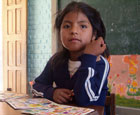Conditional Transfer Programmes
Aim to Protect the Poorest

Conditional cash transfer programmes (CCTs), or with co-responsibility, are one of the main tools of social policy governments in the region have created to reduce poverty. They are tax-free programmes that seek to raise families’ consumption levels through cash transfers – and thus lower poverty in the short-run- as well as strengthen the human capital of family members to break the intergenerational reproduction of poverty.
The basic common structure of CCTs consists of cash transfers to families with one or more children living below the poverty line, under the condition they keep commitments primarily in education, health and nutrition – for example, that their children attend school or health centers for check-ups.
CCTs have greatly expanded since the mid 1990s, when Mexico first launched the Education, Health and Food Programme (known as “Progresa”, and currently, “Oportunidades”), Brazil implemented similar programmes also aimed at low-income families with school-aged children, and these programmes started to condition the delivery of these funds.
According to ECLAC’s Social Development Division, these programmes now operate in 17 countries in the region and cover more than 22 million families; this is about 100 million people, equivalent to 17% of the population in Latin America and the Caribbean. However, on average, CCTs represent only 2.3% of total social public expenditures in the region and 0.25% of GDP.
Due to their procedures and selection techniques aimed at minimizing mistakes in exclusion (families that meet the eligibility criteria but don’t participate in the programme) or inclusion (families that don’t meet the eligibility criteria but nevertheless participate), CCTs generally allocate cash transfers to the neediest and are therefore one of the social expenditure items with greatest redistributive impact.
In addition to their level of focalization, the impact of these transfers on poverty rates at a national level depends on the coverage and amount of the cash transfers. The evidence on CCTs’ contribution to reducing poverty comes from countries in which coverage is broad and the amount of transfers is high, such as in Argentina, Brazil, Ecuador, Jamaica and Mexico. There is no evidence of any impact on poverty levels in countries where coverage and amounts of CCTs are low.
In terms of strengthening human capital, CCTs have been able to achieve greater access to education and basic health services for the poorest families and in countries where barriers to access are higher, contributing to improve intermediate objectives such as increasing school registration and attendance, coverage in periodic checkups for children and preventive health checkups. However, there is no conclusive data on the final objectives of developing human capital, such as children’s learning capabilities or nutrition.
The challenge of quality in education and public health is particularly relevant for CCTs, given that higher school registration and attendance and demand for health services do not necessarily mean that beneficiaries are receiving quality services, casting a doubt on whether these programmes are effective in developing human capital.
As these programmes expand, it will be important for transfers to the demand for public services be accompanied by greater efforts to improve supply, increasing their accessibility and quality. Coordinating sectorial social policies –particularly education and health ministries- with the government agencies in charge of CCTs plays a fundamental role in this direction.
In sum, CCTs in Latin America and the Caribbean tend to be regarded as successful in improving the living conditions of the neediest, alleviating their situation, reducing the poverty gap and increasing access to school and health services, but they are not conclusive in terms of effectively overcoming poverty in the long-run.
The main challenge of these programmes is to advance towards meeting the short-run objectives of alleviating poverty among vulnerable families through cash transfers and at the same time, attain the long-range goals of developing the assets and capabilities of human capital so families can effectively overcome poverty in a sustainable way.
This challenge could be better addressed by including CCTs in broader social protection and promotion networks, with greater resources allocated not only to raise demand, but also the supply of public services.*by Social Development Division
More IN FOCUS
ECLAC Proposes
Eight Ways to Strengthen Regional Cooperation in a Post-crisis ScenarioBroadband is Key to the Virtuous Circle of
Development
Comparing Apples with Apples in Different
Currencies
| These programmes operate in 17 Latin American and Caribbean countries and benefit over 22 million families. However, they represent only 0.25% of country GDP. | |

|
|
|
|
|
| The challenge is long-term: how to develop the assets and capabilities of human capital for families to overcome poverty in a sustainable way. | |